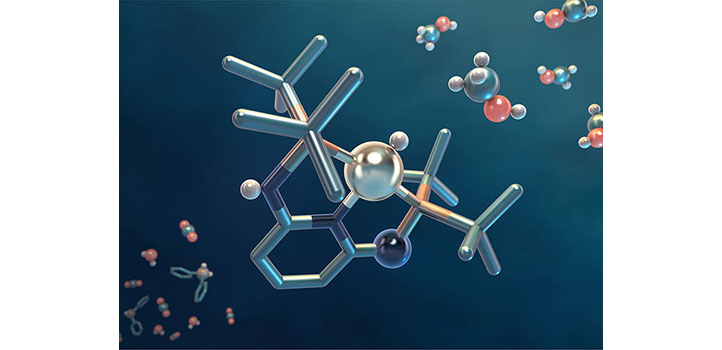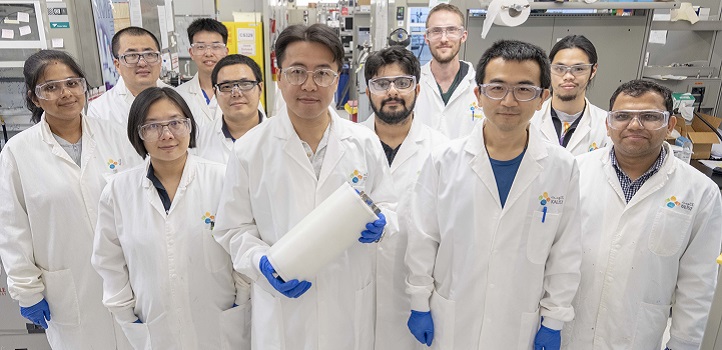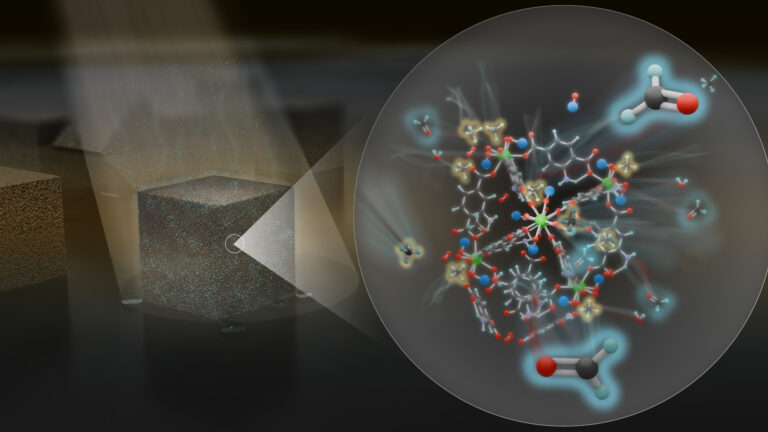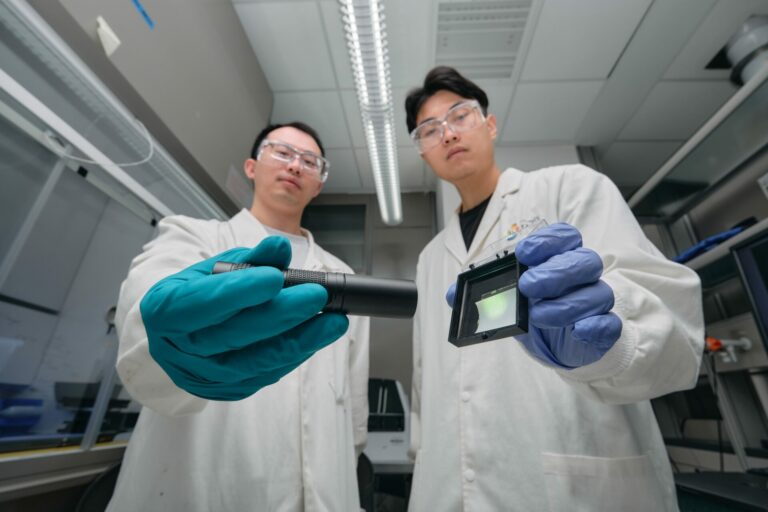Chemistry
Catalysis captured in a pincer movement
Hydrogen-powered cars and recycling CO2 are just two of the myriad of applications that could spring from catalysts based on a new ligand platform.

When Kuo-Wei Huang and his group made a seemingly simple chemical modification to a pincer catalyst system, they did not observe the anticipated modest alteration to the catalyst’s reactivity. Instead, they discovered totally distinct catalytic behaviors. A decade of study later, the catalytic platform discovered by the Huang group looks set to spawn a new branch of catalyst chemistry, with the potential to drive revolutionary chemical transformations.

Kuo-Wei Huang (center) and his researchers are working on a catalytic platform that has the potential to be a game changer for catalyst chemistry.
© 2018 KAUST
Catalysts are chemical entities that assist with the making and breaking of bonds, often with exquisite selectivity. They are used across all areas of production, from commodity chemicals to pharmaceutical manufacturing, and they underpin the manufacturing of many chemicals and materials in use today.
In most catalysts, including organometallic catalysts where each metal ion is wrapped in a carbon-based ligand, metals are the star of the show: they are the center of catalytic reactivity where bond creation takes place. The ligand might fine tune that reactivity, but it is essentially there to provide support. However, in Huang’s new catalyst family, that situation can be reversed: the ligand can be the site of catalytic activity where new bond formation takes place, and the metal is relegated to the support role.
“For the last 100 years, we have been talking about how to modify the ligand to manipulate the reactivity of the metal center,” Huang says. “Now we can also use metal coordination to change the reactivity of the organic component—and maybe reach some unprecedented reactivities that cannot be achieved otherwise,” he says.
KAUST researchers are designing custom catalysts for a myriad of uses with unprecedented reactivities.
© 2019 KAUST
Nippy performance
Huang’s new ligands fall into a class known as pincer ligands, first studied in the early 1970s, which get their name from the pincer-like grip they exert on the central metal ion. The ligand centers on a six-membered pyridine ring, notable because it possesses a special chemical feature called aromaticity, a state of electronic balance that makes it highly stable. Carbon-based side chains dangling from the pyridine ring form the pincer grip on the metal ion.
That a hydrogen could be plucked from one of the CH2 groups in the side chain was a mere curiosity for three decades. Then in 2005, researchers realized that this process disturbs the aromatization of the pyridine ring and turns it into a very active catalyst. “The central pyridine ring is very eager to regain the aromaticity,” Huang says. Most notably, the catalyst can even split water molecules into oxygen and hydrogen, a potential carbon-free future fuel. “This is a stunning reaction,” Huang says.
Huang’s entry into pincer-ligand chemistry came from a seemingly small modification: he swapped the key CH2 group for an NH group and discovered that the reactivity was completely changed. Far from decomposing water, the catalyst was unreactive, even in water heated to boiling. “That was the first big difference we observed,” Huang says.
Differences such as these prompted the team to look more closely at its new pincer catalysts. Huang showed that in its reactive dearomatized form, with certain metals, the ligand’s pyridine component retained some pseudoaromaticity1. This in turn made the nitrogen arm of the pincer ligand electron-rich and highly reactive. “It is because of this special reactivity that we are no longer restricted to the reactivity of the metal center,” Huang says.
In subsequent studies, the team has shown the iminic nitrogen of its pincer ligand performs like an extremely reactive form of carbon called a carbene2. “That has never been achieved before,” Huang says. For example, the team has shown they can use the catalyst to persuade carbon dioxide, a very unreactive molecule, to react with nitrogen-based molecules to make valuable chemicals3. Because of its unusual stability toward water, the team could also develop another catalyst for the decomposition of formic acid, a potential fuel, to selectively release hydrogen, which can be used to power an electric car4. A power generator developed by the team, fueled by formic acid, is going to be commercialized next year, Huang says.

Huang swapped the key CH2 group for an NH group and discovered that the reactivity was completely changed.
© 2018 KAUST
“No one would have envisaged that a start with the organometallic chemistry of catalyst design would lead to making electric cars,” Huang says. Huang credits KAUST’s funding model, which provides baseline funding for faculty members, for allowing him to pursue the initial catalyst research that led to this unexpected new branch of chemistry.
These examples of the catalyst’s utility published so far are just a glimpse of what is to come, he adds. “The important thing is we have created a new way for catalysts to be designed, plus set up a platform open for opportunities.”
References
- Gonca̧lves, T.P. & Huang, K.-W. Metal−ligand cooperative reactivity in the (pseudo)-dearomatized PNx(P) systems: The influence of the zwitterionic form in dearomatized pincer complexes. Journal of the American Chemical Society 139, 13442−13449 (2017).| article
- Li, H., Gonca̧lves, T.P., Hu, J., Zhao, Q., Gong, D., Lai, Z., Wang, Z., Zheng, J. & Huang, K.-W. A pseudodearomatized PN3P*Ni−H complex as a ligand and σ‐nucleophilic catalyst. Journal of Organic Chemistry 83, 14969–14977 (2018).| article
- Li, H., Gonca̧lves, T.P., Zhao, Q., Gong, D., Lai, Z. Wang, Z., Zheng, J. & Huang, K.W. Diverse catalytic reactivity of a dearomatized PN3P*–nickel hydride pincer complex towards CO2 reduction. Chemical Communications 54, 11395—11398 (2018).| article
- Eppinger, J. & Huang, K.W. Formic acid as a hydrogen energy carrier. ACS Energy Letters 2, 188−195 (2016).| article
You might also like

Chemistry
Hollow molecules offer sustainable hydrocarbon separation

Chemistry
Maximizing methane

Chemistry
Beating the dark current for safer X-ray imaging

Chemical Engineering
Net benefits for advanced materials design

Chemical Engineering
Ancient architecture inspires a window to the future

Chemistry
Squeezing more from carbon dioxide

Chemistry
Finding catalytic power in unexpected places

Chemistry




